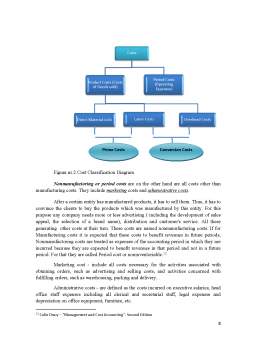Extras din referat
INTRODUCTION
What does the cost mean? Is it the price you pay for something of value? A cash outflow? Something that affects profitability? In this essey I will show how the costs can be defined, how important they are for an organization, how they can be classified and how can they be different according to the established purposes.
Accountants define the cost as a resource sacrificed (used) or forgone to achieve a specific objective. It is usually measured as the monetary amount that must be paid to acquire goods and services.
For example, it might cost $5,000 per month to rent retail space in a shopping center. To guide their decisions, managers often want to know how much a particular thing costs. This “thing” is called a cost object, anything for which a measurement of the costs is desired. This cost object can be any product, activity, service, department, organizational unit or a physical element of a certain interest for the management and for which managers want to know its cost. Examples of cost objectives include the cost for manufacturing a product or a manufacturing line, the cost with employees'payment, the cost of a department explotation, the cost of the electric power or of a sales area.
PURPOSES:
Cost represents a very important element in a organization, which the managers always should put emphasis in their activity. Why is so important the cost? Because on it depends the main purpose of organization, that of getting profit and in this case the company’s duration of life. Managers must understand the concepts and terms about cost in order to interpret and act on accounting information. The cost information is used by managers in two main ways: for making decisions (for exemple, how to price differtent products or if they should change their manufacturing methods, or to expand a department, or how much to invest in a project or in advertising, ) and for implementing decisions, by influencing and motivating employees or customers.
For instance, comparing budgeted cost, which is a forecasted cost( a future cost) to actual costs, which is incurred (a historical cost) helps managers evaluate efficiency and managerial performance and learn about how they can do better in future.
For the most appropriate decissions taking and implementing, it is very important to be a precise attribution of objective cost. Thus they have to measure and to establish as accurate as possible the cost of resources which were used by a cost object and by using the most appropriate methods of cost evaluations.
A cost represents a regrouping of expenses referring to a definite object ( a product, a work, an order etc.). Thus the cost includes:
-expenses that can be followed by payments (as it is the case of buying from a customers);
-expenses which don't generate payments ( as there are those expenses calculated with amortization and provisions;
-or which generate loses (an equipment without insurrance that is destroyed in a fire or in a flood).
The cost has to be considered a “subjective” element that depends on the options regarding the evolution methodology and that depends on the management decissions of the firm.
Type of costs
In managerial accounting, the term cost is used in many different ways. The reason is that there are many types of cost, and these cost are classfied differently according to the type of organization involved. In the following analysis i am going to present the most important of them.
Starting with the neccessity of costs' calculation and the necessity of analytical results, there have been adopted two classifications' patterns: direct costs and indirect costs and also variable costs and fixed costs.
According to the way in which they can be attributed to the cost object, production cost is made of direct and indirect costs.
Direct costs (DC) are connected to the cost object (product, work, or service) and they can be attributed directly to this, in an advantageous way (fesable) from economic point of view.
@ Example - For a soft drinks' manufacturer, the cost of aluminum box or the cost of bottle is a direct cost because it can be easily attributed to a soft drink.
Indirect costs (IC)- are related to the cost object, but they can't be attributed directly to it in an advantageous way (fesable) from economic point of view. Indirect costs are given to the cost object in accordance with some allocation procedures by using some allocation bases.
@ Example - For a manufacturer of soft drinks, the sallaries of the managers who supervise the production of numerous types of soft drinks represents an indirect cost.
Analysing the relation that it is created between the evolution of different expenses and the modification of production, the production cost is made of variable cost and fixed cost.
Preview document
Conținut arhivă zip
- Cost Term and Purposes.docx














